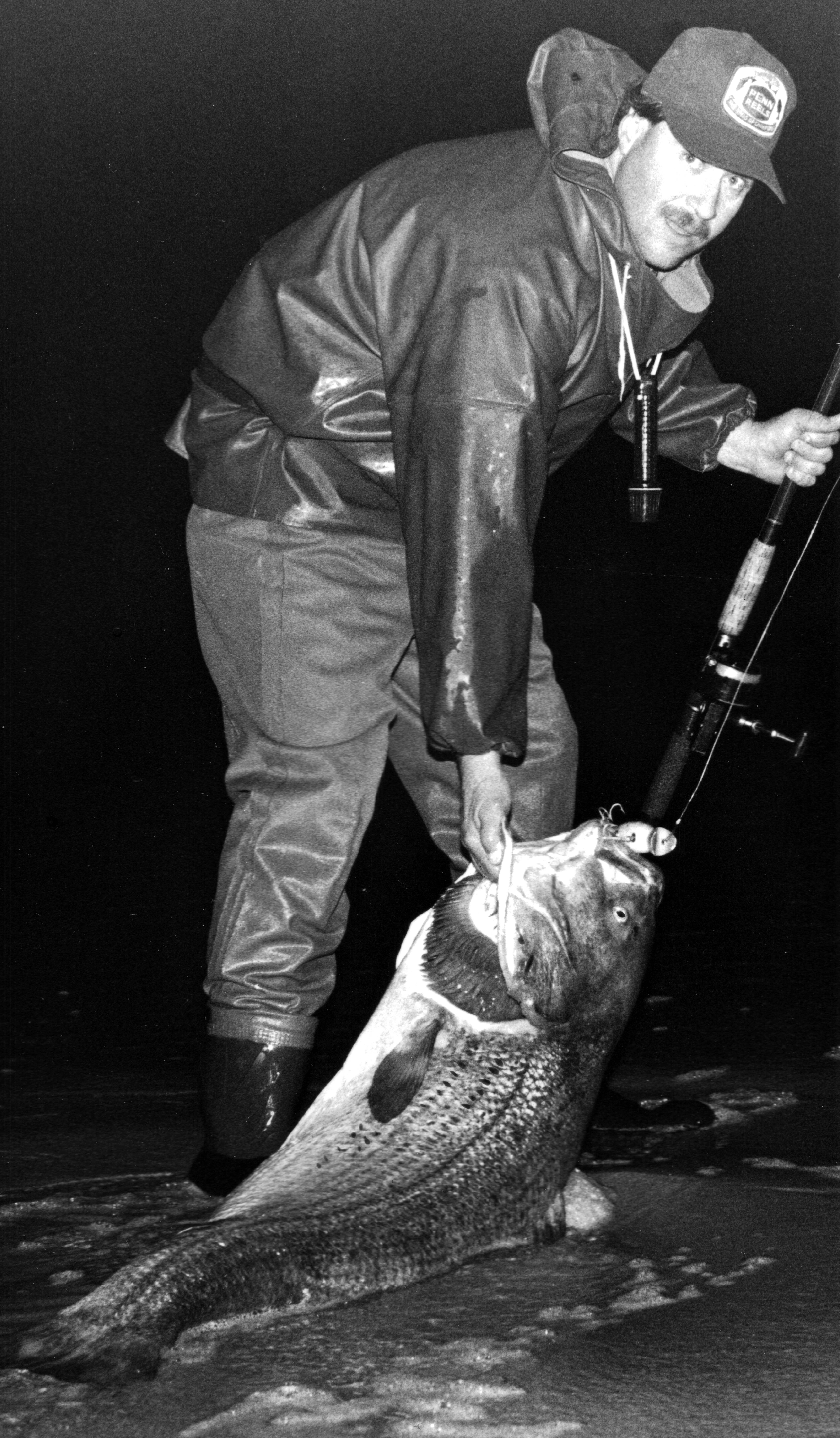
Nearly four centuries of fishing literature tracks the biggest reported stripers in U.S. history.
From the Pilgrims of Plymouth Colony to anglers of the 21st Century, the striped bass has captured our imagination, attention, and reverence as The Great American Fish.
For example, in his book New England Prospect published in 1634, an Englishman named William Wood, who lived in the Massachusetts Bay Colony from 1629 to 1633, called the striped bass “one of the best fishes in the country” and noted “though men are soon wearied with other fish, they are never with the basse.” He also observed that “of these fishes, some be three and four foote long, some bigger, some lesser.”
Centuries later in American Game Fishes: Their Habits, Habitat, and Peculiarities; How, When and Where to Angle for Them published in 1892, Francis Endicott wrote “there is a most interesting uncertainty in angling which constitutes its great charm; you know not whether your cast will attract a minnow or a whale, and this is perhaps better exhibited in angling for the Striped Bass than for any other fish, for in many of his haunts you cannot know whether you will strike a fish of half a pound or one of sixty pounds.”
In his1941 manuscript Studies on the Striped Bass of the Atlantic Coast fisheries scientist and Yale University Professor Daniel Merriman reported “individuals up to 25 – 30 pounds are by no means rare, and not infrequently striped bass up to 50 – 60 pounds are caught.” A decade later in 1953, Henry Bigelow – who helped found the Woods Hole Oceanographic Institution – and his colleague at Woods Hole, William Schroeder, published their comprehensive volume Fishes of the Gulf of Maine, which remains an authoritative, highly consulted reference on the life history of fishes to this day. In their chapter on striped bass, according to Bigelow and Schroeder, at that time “fish of 50 – 60 pounds are not exceptional.”

Truly Exceptional Bass
Many anglers consider the dividing line between a large striped bass and a true trophy fish to be 60 pounds. In The Striped Bass 60+ Pound Club Tony Checko points out that catching a 60-plus-pound striper is a special event. His 2008 book catalogs records of 55 striped bass between 60 and 70 pounds, and 12 between 70 pounds and 78.5 pounds, caught by anglers over the past century and provides detailed information on a number of noteworthy catches of stripers over 70 pounds.
Some notable catches Checko discusses in detail include the following:
A 73-pound striper taken on an eel drifted from a small skiff by Charles B. Church in August of 1913 at Quicks Hole, a narrow strait in the Elizabeth Islands between Nashawena Island and Pasque Island that connects Vineyard Sound to Buzzards Bay. Church’s catch was later acknowledged in O.H.P. Rodman’s book Striped Bass: Where, When and How to Catch Them published in 1944; it was also mentioned in ichthyologist and Cornell University Professor of Zoology Edward Raney’s 1952 synopsis of The Life History of the Striped Bass and Bigelow and Schroeder’s Fishes of the Gulf of Maine.
A 73-pound striper caught on a swimming plug fished on wire line by Charles Cinto at the Sow and Pigs Reef located to the southwest of Cuttyhunk Island, Massachusetts in 1967. Cinto’s bass tied the record for the largest striper caught in Massachusetts waters originally set by Church’s 1913 fish.
A 76-pound striper caught by Bob Rochetta in July 1981 while drifting a live eel in the area known as the Great Eastern located to the east of Montauk Point, New York. At the time, this fish set the striped bass All-Tackle World Record and remains the New York state record.
A 78-pound, 8-ounce striper caught in the Atlantic City, New Jersey surf off the Vermont Avenue jetty in September 1982 by Albert McReynolds. This fish hit a swimming plug fished by McReynolds during a nor’easter at night and became the new All-Tackle World Record and is still the New Jersey state record striper.
In addition to Checko’s recounting of the details associated with some of these record catches of The Striped Bass 60+ Club, some other stripers of note landed by anglers include:

Tony Stezko’s 73-pounder caught on a black fly teaser above a live eel while surf fishing on Cape Cod at Nauset Beach in Orleans, Massachusetts in November 1981, which also tied Church’s and Cinto’s Massachusetts state record.
Peter Vican’s 76-pound, 14-ounce striper caught in 2008 while drifting live eels off Block Island that set the Rhode Island state record, a record he broke himself 3 years later when he scored a 77-pound, 4-ounce bass on a live eel again off Block Island in 2011.
And of course there is Greg Myerson’s 2011 catch, an 81-pound, 15-ounce bass caught while drifting live eels over rocky structure at the Southwest Reef off the coast of Westbrook, Connecticut in Long Island Sound breaking the All-Tackle World record previously held by McReynolds and establishing a new Connecticut state record.
Aside from these trophy catches there are other historical accounts of big bass contained in the scientific literature. For example, in his 1887 manuscript entitled The River Fisheries of Maine pioneering fisheries biologist and Maine’s first Commissioner of Fisheries Charles Atkins includes what may be the first records of 80-plus-pound stripers. According to Atkins, a commercial fisherman named M.B. Spinney took a bass of 89 pounds near Georgetown, Maine in one of his stop nets, a type of set net commonly used along beaches at that time. Atkins also relates Spinney’s account of another recently captured striper weighing 100-1/2 pounds taken in Middle Bay, an arm of Casco Bay, Maine.
Several other reports mention that, in one day in July of 1887, Francis W. Miner of Providence Rhode Island caught nine stripers fishing from a bass stand near the southeast point of Block Island, the largest weighing between 85 and 86 pounds. Bass stands were narrow, pier-like platforms extending seaward over rocky shoreline areas built by New England fishing clubs in the 1800’s to improve access to productive waters known to be frequented by big bass. Minor’s bass appears to be the first record of an 80-plus-pound striper caught on rod and reel.
America’s Fish
According to University of California Davis’s Center for Watershed Science Water Blog the record books of the Marin Rod and Gun Club include a photograph of Charles Bond hefting a large striper with a caption indicating that the fish was caught in 1912 in San Antonia Creek, a tributary to the San Francisco Bay, and weighed in at 87-1/2 pounds. It is interesting to note that striped bass are not native to the west coast. According to historical lore, easterners moving to the San Francisco Bay area in the late 1800’s missed the angling excitement provided by stripers and convinced the U.S. Fish Commission to introduce their favorite species to the estuary.
In 1879 under the auspices of fisheries biologist Livingston Stone, 132 fingerlings from the Navesink River in New Jersey were transported via rail car and released into Suisun Bay near Martinez, California. In 1882, another 300 fingerlings were sent west from the Navesink and released into the western reaches of lower Suisun Bay. By the 1890’s the population was thriving and the stripers range on the west coast now extends from Los Angeles north to the Columbia River.

In 1941, striped bass ascending the Cooper River on a spawning run accidentally became landlocked during construction of the Santee Cooper Reservoir system in South Carolina. It shortly became apparent to fisheries biologists that stripers could survive in freshwater systems if environmental conditions such as cooler summer water temperatures and acceptable dissolved oxygen levels existed and adequate forage was available. This led to a movement in the next several decades to stock striped bass in reservoir and feeding river systems throughout the United States and now, more than 30 states have freshwater striped bass populations in reservoirs, lakes and rivers.
Fast forward to May 1992 when Hank Ferguson landed a 67-pound, 8-ounce striper in O’Neill Forebay, a holding pond adjacent to the San Luis Reservoir on the San Luis Creek west of Los Banos, California to set the All-Tackle World Record for freshwater/landlocked bass. Then fast forward again to the Black Warrior River in west-central Alabama where James Bramlett scored with a 69-pound, 9-ounce striper in February 2013 that became the new All-Tackle record for freshwater striped bass.
| BOFFFF’S |
| Based on available data, scientists believe that bass of 30 pounds or greater are probably females. In addition, larger females produce exponentially more eggs than smaller females; the BOFFFF principle (Big Old Fat Fecund Female Fish) therefore states that the harvest of older, larger striped bass removes these individuals from the reproductive population, eliminating their value to the overall success of the stock.
If you do catch a personal best, striped bass of a lifetime, we encourage you to measure, photo and release the fish as fast as possible to ensure its survival and contribute to the conservation of striped bass and the long-term sustainability of the fishery. |
In terms of the biggest striped bass on record, ichthyologist H.M. Smith, who served as a deputy commissioner of the U.S. Bureau of Fisheries, reported in The Fishes of North Carolina in 1907 that the heaviest striped bass for which definitive records exist are several stripers weighing 125 pounds that were taken in commercial haul seine nets at Edenton, North Carolina in April 1891. Bigelow and Schroeder’s 1953 Fishes of the Gulf of Maine confirms Smith’s report that the heaviest striped bass on record include several 125-pounders taken in haul seines near Edenton in 1891. Fishes of the Gulf of Maine also refers to a striped bass weighing 112 pounds which was reported to be at least 6 feet long taken at Orleans, Massachusetts ‘many years ago’ although few other details are provided.
Perhaps the most recent proof that extremely large stripers still roam the striper coast comes from the 92-pounder taken at the mouth of the Patuxent River, a tributary to Chesapeake Bay by Maryland Department of Natural Resources staff while netting stripers during a research project in 1995. A mount of this behemoth hangs in the DNR offices in Annapolis.
So, although hooking into a striper over 60 pounds may be a rare event, history shows that at any time, one of your upcoming casts could connect you tight with a fish of a lifetime.




